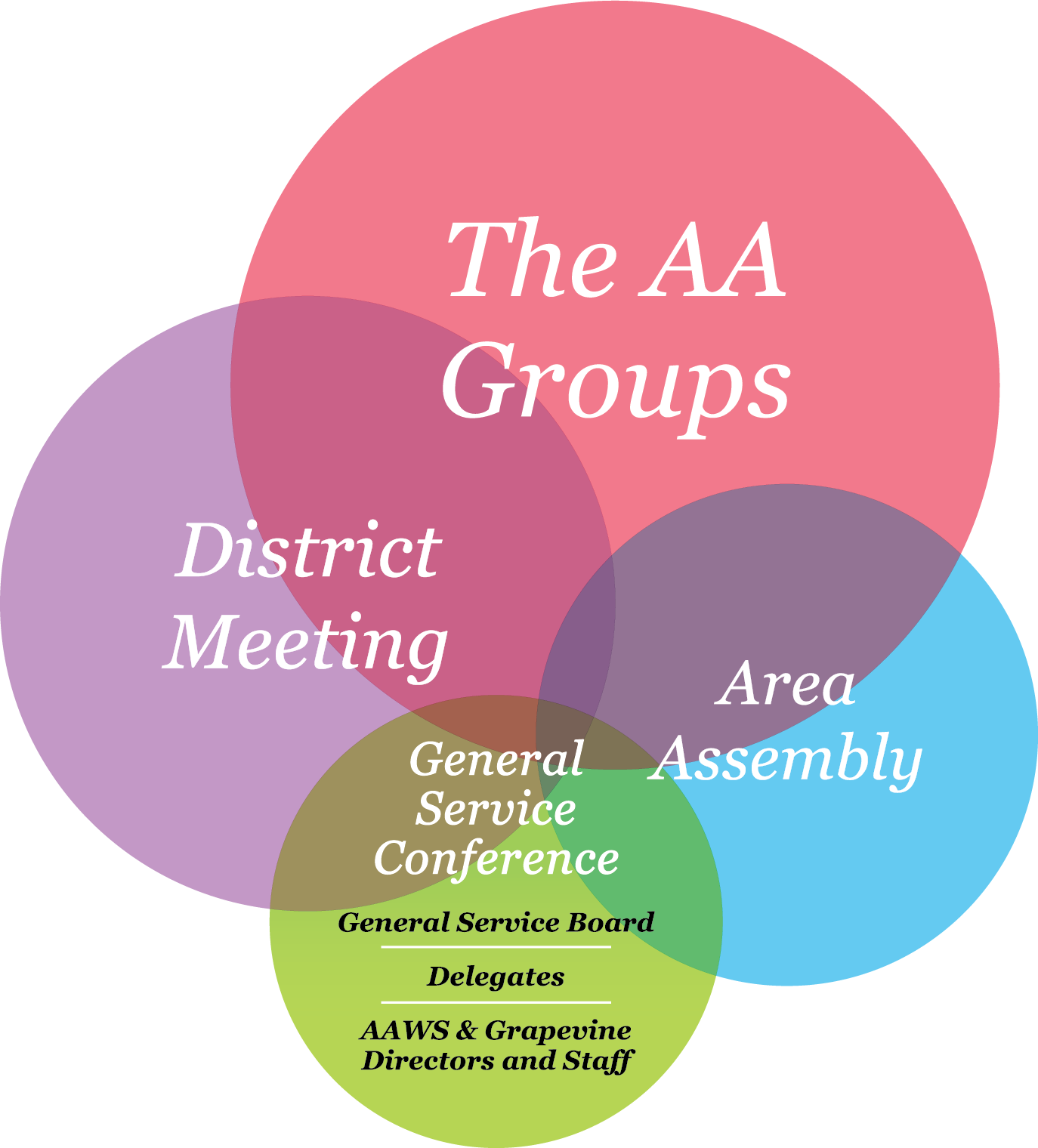A.A.'s Responsibility Statement
I am responsible, when anyone, anywhere reaches out for help, I want the hand of A.A. always to be there. And for that: I am responsible.

Service in the Group
In A.A., everything starts with the group — it is the place where recovery begins for most alcoholics and is the basic building block of the entire Fellowship. But, for a group to keep going, all kinds of service must be done.
It is through the combined efforts and ongoing commitment of group members that:
- A meeting place is readily available and maintained
- Meetings are arranged for the benefit of the alcoholics in attendance
- Calls for help are answered
- Voluntary contributions are collected to keep the group and the Fellowship going financially.
- Literature is provided for all members and lists of local group meetings are made available.
- Continuing contact is sustained with the rest of A.A.
The A.A. group
The entire structure of A.A. depends upon the participation and conscience of the individual groups.
Service Beyond the Group
General Service Representatives (GSRs)
The general service representatives (GSRs) of the U.S. and Canada are the foundation of our general service structure. Just as members make up a community, each A.A. group is part of a larger whole. Through your GSR, you can make your group’s voice heard.
Each group's GSR usually participates with the GSRs of other local groups in regular district meetings. There the GSRs discuss plans and make decisions on how to best serve the local groups. They also learn more about what is happening in A.A. world service. GSRs also take part in area assemblies. They give input to those who represent your area at the General Service Conference.
District Committee Members (DCMs)
Each district has a leader of the district committee of GSRs called the district committee member (DCM) Thanks to the participation of the GSRs, the DCM is exposed to the group conscience of that district.
These DCMs are essential links between the group GSRs and the area delegate to the General Service Conference. DCMs pass on their district’s thinking to area committees and service workers. They carry information back to local GSRs, who in turn keep their group members informed on various A.A. issues.
Service Committees
Many groups, districts, and areas carry the A.A. message into treatment settings and correctional institutions. The goal is to ensure that the A.A. message reaches those who may be the most in need. Often organized by A.A. service committees, this work may involve working with professionals or other non-A.A. members.
Groups often provide speakers to go into these institutions. They can also provide contacts for A.A. members who are released from these institutions. This helps them to make contact with A.A. in their communities when they get out.
How A.A. Service is Organized

Frequently Asked Questions
What is a GSR?
The general service representative (GSR) is an elected member of your home group. It is a two-year service commitment. The GSR is your home group’s link to A.A. as a whole. GSRs attend district meetings and area assemblies, relaying information between group members and the general service structure of A.A. For more information, see the pamphlet "GSR – General Service Representative."
What is a DCM?
The District Committee Member (DCM) is the elected leader of the district committee which is made up of all GSRs in the district. The DCM reports information from GSR meetings at area meetings. For more information see the DCM pamphlet.
What are central offices or intergroups?
A central office or intergroup is an A.A. service office that involves partnership among groups in a community — just as A.A. groups themselves are partnerships of individuals. A central office/intergroup is established to carry out certain functions common to all the groups — functions that are best handled by a centralized office — and it is usually maintained, supervised and supported by these groups in their general interest. It exists to aid the groups in their common purpose of carrying the A.A. message to the alcoholic who still suffers.
Where can I find the form I need to send to GSO?
GSO New Group Listing Guidelines / Form
GSO Group Information Change Form
GSO DCM & DCMC Information Change Form
If you need a form that is not on this list, please contact your regional correspondent.
How do you become an A.A. group member?
Group membership requires no formal application. As stated in Tradition Three, “The only requirement for A.A. membership is a desire to stop drinking." Just as we are members of A.A. if we say we are, so are we members of a group if we say we are.
The A.A. Group >
How do we start a new A.A. group?
Reasons for starting a new group vary, but the ways to go about it are basically the same. Important to establishing an A.A. group is the need for one as expressed by at least two or three alcoholics; the cooperation of other A.A. members; a meeting place; a coffee pot; A.A. literature and meeting lists; and other supplies. Once the group is off to a good start, it would be helpful to announce its presence to neighboring groups; your local intergroup (central) office, if there is one; your district and area committees; and the General Service Office. These sources can provide much support. Contact GSO for copies of the New Group Form, which should be completed and returned for the new group to be listed. Each new group receives a complimentary handbook and a small supply of literature at no charge when it is listed with GSO (one of the many services made possible by the regular support of other A.A. groups and individual members). The New Group Form can be downloaded from our website (aa.org), or requested by mail at GSO, Box 459, Grand Central Station, New York, NY 10163.
I’m a new service committee chair. Where can I find information on my position?
Congratulations on your new position! You can read about getting listed with GSO and obtaining material to help you get started in your new role. Specific pages for committees on Accessibilities, Archives, Cooperation with the Professional Community, Corrections, Literature, Public Information, Remote Communities and Treatment contain pamphlets, service material, guidelines and workbooks that will help you perform your duties.
